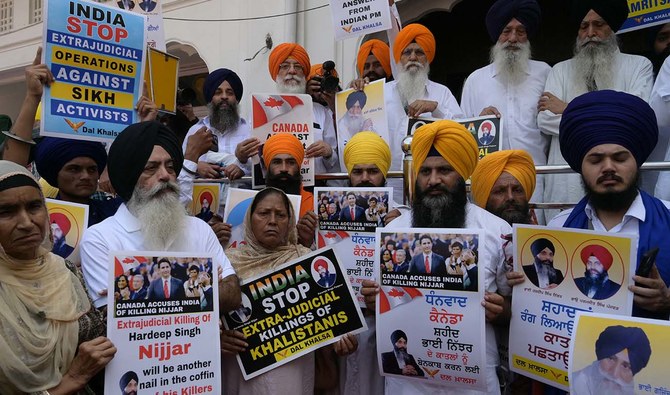BELGRADE: Until six months ago, the Lovimi family from Iran had never heard of Serbia.
But here they are, currently in Belgrade, after arriving without visas last August, waiting to continue on to Germany, where they plan to build a new and better life in the future.
The family of four comes from the town of Ahvaz in the province of Khuzestan in Iran’s southwest, where the majority of the population is Arabic.
They complain that, as Arabs, they have few rights in Iran, their children are forced to learn Farsi and not Arabic in school, and they are treated as second-class citizens, with little hope of finding a job.
So, when Belgrade and Tehran abolished reciprocal tourist visas last August, the Lovimis decided to take their chance and come to Belgrade. And from there, they hoped to continue on to the EU and a better future.
The Lovimis are not the only ones. According to official statistics, around 7,000 fellow Iranians have arrived in Serbia since August, intially as tourists, but some of them with no intention of returning home.
Shahla Lovimi, a 40-year-old housewife, says she and her family had originally gone to Turkey with the intention of carrying on from there to Germany via Italy.
“We have never had the intention to go through Belgrade. We have never heard about Belgrade. We went to Turkey and the smuggler took us here,” she said.
She and her car mechanic husband and their two children, aged 11 and 17, paid the smuggler €22,000 ($27,000).
For two months, they lived in various Belgrade apartments and hostels, waiting for the smuggler to pick them up and take them to the EU by car.
But when the smuggler vanished four months ago, leaving them on their own, the Lovimis turned to Info Park, a local non-governmental group helping refugees.
According to Info Park’s communication officer Stevan Tatalovic, a number of Iranians are using the visa liberalization agreement to come to Europe and stay there illegally as migrants.
Their intention is not to seek asylum in Serbia, but to continue on, often to Britain or other EU countries, Tatalovic said.
Serbia argues that visa liberalization will help develop tourism between the two countries and attract business investment in the longer term.
Nevertheless, Serbian Trade Minister Rasim Ljajic said the two countries are aware of, and will clamp down on any possible abuses of the visa-free scheme. However, Info Park’s Tatalovic said that with direct flights between Tehran and Belgrade resuming after 27 years, up to 600 Iranians could soon be arriving in Serbia every week.
Two airlines are already offering flights and a third will follow in April and most of the flights are already fully booked until the end of summer.
Iranians use visa-free travel to Serbia to flee to EU
Iranians use visa-free travel to Serbia to flee to EU

Indonesia welcomes expanded Makkah Route access as pilgrims start departing for Hajj

- Indonesia will be sending 241,000 pilgrims this pilgrimage season
- The Makkah Route initiative is available in 3 Indonesian cities
JAKARTA: Indonesia on Sunday welcomed the expansion of the Makkah Route initiative to three airports, as the first batch of the country’s largest Hajj contingent to date departed for Saudi Arabia.
The world’s biggest Muslim-majority nation will be sending 241,000 pilgrims to Saudi Arabia this year for the spiritual journey that is one of the five pillars of Islam.
Although the Hajj this year is expected to start on June 14 and end on June 19, many pilgrims depart early to make the most of the once-in-a-lifetime opportunity to fulfill their religious duty.
As Indonesia’s first Hajj flight carrying nearly 400 pilgrims departed from Soekarno-Hatta International Airport in the early hours of Sunday, Religious Affairs Minister Yaqut Cholil Qoumas said he was grateful to the Saudi leadership for adding the Makkah Route initiative in other Indonesian cities.
“On behalf of the Indonesian government, I thank the Saudi government for providing additional fast-track facilities, other than Jakarta, it is now available in Solo and Surabaya,” Qoumas said after he sent off the first group in the Indonesian capital.
“Hopefully this will give ease, benefit, and a smooth journey for all Indonesian pilgrims.”
Launched in 2019, the Kingdom’s Makkah Route initiative is a pre-travel program created to help pilgrims meet all the visa, customs and health requirements at the airport of origin, and save them long hours of waiting before and upon arrival in Saudi Arabia.
This year, the initiative will benefit more than 128,000 Indonesian pilgrims who will leave from the three selected cities.
“We saw the fast-track service at the airport. It doesn’t take any longer than two minutes. It’s very fast, very helpful for the pilgrims. When they arrive, they don’t have to go through any other immigration process, they can just hop on the bus and begin their worship in the holy land,” Qoumas said.
This year, Saudi Arabia increased Indonesia’s quota of pilgrims by 20,000, from 221,000 last year, making it the biggest in the Southeast Asian nation’s history.
The highest quota in previous years came before the COVID-19 pandemic, in 2019, when the Kingdom approved a quota of 231,000 pilgrims for Indonesia.
The additional quota will help shorten the wait for some pilgrims by a few years, which is especially important for elderly pilgrims. Many Indonesians have to wait up to 45 years for their turn, according to official estimates.
Ace Hasan Syadzili, a member of Indonesia’s House of Representatives, was also present to see off the first batch of pilgrims on Sunday, commended the Makkah Route initiative.
“This is certainly helpful. Looking at the previous years, without fast track the immigration can take between two to five hours. But this fast track will speed up services for Hajj pilgrims,” Syadzili said.
“We will continue to oversee and supervise the Hajj management process this year so that it is in line with the people’s expectations.”
US Marine pilot arrested in Australia worked with Chinese hacker, lawyer says

- Daniel Duggan, a naturalized Australian citizen, fears requests by Western intelligence agencies for sensitive information were putting his family at risk
SYDNEY: A former US Marine pilot fighting extradition from Australia on US charges of training Chinese military pilots to land on aircraft carriers, unknowingly worked with a Chinese hacker, his lawyer said.
Daniel Duggan, 55, a naturalized Australian citizen, feared requests by Western intelligence agencies for sensitive information were putting his family at risk, the lawyer said in a legal filing seen by Reuters.
The lawyer’s filing supports Reuters reporting linking Duggan to convicted Chinese defense hacker Su Bin.
Duggan denies the allegations that he broke US arms control laws. He has been in an Australian maximum security prison since his 2022 arrest after returning from six years working in Beijing.
US authorities found correspondence with Duggan on electronic devices seized from Su Bin, Duggan’s lawyer Bernard Collaery said in the March submission to Australian Attorney General Mark Dreyfus, who will decide whether to surrender Duggan to the US after a magistrate hears Duggan’s extradition case.
The case will be heard in a Sydney court this month, two years after his arrest in rural Australia at a time when Britain was warning its former military pilots not to work for China.
Su Bin, arrested in Canada in 2014, pleaded guilty in 2016 to theft of US military aircraft designs by hacking major US defense contractors. He is listed among seven co-conspirators with Duggan in the extradition request.
Duggan knew Su Bin as an employment broker for Chinese state aviation company AVIC, lawyer Collaery wrote, and the hacking case was “totally unrelated to our client.”
Although Su Bin “may have had improper connection to (Chinese) agents this was unknown to our client,” Duggan’s lawyer wrote.
‘OVERT INTELLIGENCE CONTACT’
AVIC was blacklisted by the US last year as a Chinese military-linked company.
Messages retrieved from Su Bin’s electronic devices show he paid for Duggan’s travel from Australia to Beijing in May 2012, according to extradition documents lodged by the United States with the Australian court.
Duggan asked Su Bin to help source Chinese aircraft parts for his Top Gun tourist flight business in Australia, Collaery wrote.
The Australian Security Intelligence Organization (ASIO) and US Navy criminal investigators knew Duggan was training pilots for AVIC and met him in Australia’s Tasmania state in December 2012 and February 2013, his lawyer wrote.
ASIO and the US Navy Criminal Investigation Service did not respond to Reuters requests for comment on the meetings. ASIO has previously said it would not comment as the matter was before the court.
“An ASIO officer suggested that while carrying on his legitimate business operations in China, Mr.Duggan may be able to gather sensitive information,” his lawyer wrote.
Duggan moved to China in 2013 and was barred from leaving the country in 2014, his lawyer said. Duggan’s LinkedIn profile and aviation sources who knew him said he was working in China as an aviation consultant in 2013 and 2014.
He renounced his US citizenship in 2016 at the US embassy in Beijing, backdated to 2012 on a certificate, after “overt intelligence contact by US authorities that may have compromised his family safety,” his lawyer wrote.
His lawyers oppose extradition, arguing there is no evidence the Chinese pilots he trained were military and that he became an Australian citizen in January 2012, before the alleged offenses.
The United States government has argued Duggan did not lose his US citizenship until 2016.
More than 300 dead in Afghanistan flash floods: WFP

- Heavy rains on Friday sent roaring rivers of water, mud crashing through villages in several provinces
- Baghlan province hardest hit with over 300 casualties there alone, thousands of homes destroyed
LAQAYI, Afghanistan: More than 300 people were killed in flash floods that ripped through multiple Afghan provinces, the UN’s World Food Programme said Saturday, as authorities declared a state of emergency and rushed to rescue the injured.
Many people remain missing after heavy rains Friday sent roaring rivers of water and mud crashing through villages and across agricultural land in several provinces, causing what one aid group described as a “major humanitarian emergency.”
Survivors on Saturday picked through muddy, debris-littered streets and damaged buildings, an AFP journalist saw, as authorities and non-governmental groups deployed rescue workers and aid, warning that some areas had been cut off by the flooding.
Northern Baghlan province was one of the hardest hit, with more than 300 people killed there alone, and thousands of houses destroyed or damaged, according to WFP.
“On current information: in Baghlan province there are 311 fatalities, 2,011 houses destroyed and 2,800 houses damaged,” Rana Deraz, a communications officer for the United Nations agency in Afghanistan, told AFP.
There were disparities between the death tolls provided by the government and humanitarian agencies.
The UN’s International Organization for Migration said there were 218 deaths in Baghlan.
Abdul Mateen Qani, spokesman for the interior ministry, told AFP that 131 people had been killed in Baghlan, but that the government toll could rise.
“Many people are still missing,” he said.
Another 20 people were reported dead in northern Takhar province and two in neighboring Badakhshan, he added.
Taliban government spokesman Zabihullah Mujahid said on X: “Hundreds of our fellow citizens have succumbed to these calamitous floods.”
He added “the deluge has wrought extensive devastation upon residential properties, resulting in significant financial losses.”
Torrential rains caused heavy damage in Baghlan, Takhar and Badakhshan, as well as western Ghor and Herat provinces, officials said, in a country wracked by poverty and heavily dependent on agriculture.
“My house and my whole life was swept away by the flood,” said Jan Mohammad Din Mohammad, a resident of Baghlan provincial capital Pul-e-Khumri.
His family had managed to flee to higher ground but when the weather cleared and they returned home, “there was nothing left, all my belongings and my house had been destroyed,” he said.
“I don’t know where to take my family... I don’t know what to do.”
Emergency personnel were rushing to rescue injured and stranded Afghans.
The air force said it had started evacuation operations as skies cleared Saturday, adding that more than 100 injured people had been transferred to hospital.
“By announcing the state of emergency in (affected) areas, the Ministry of National Defense has started distributing food, medicine and first aid to the impacted people,” it said.
An AFP journalist saw a vehicle laden with food and water in Baghlan’s Baghlan-i-Markazi district, as well as others carrying the dead to be buried.
United Nations chief Antonio Guterres “expresses his solidarity with the people of Afghanistan (and) extends his condolences to the families of the victims,” his spokesman Stephane Dujarric said, adding that the UN was working with local authorities on providing assistance.
The International Rescue Committee was also preparing a rapid response, adding that the floods should act as an “alarm bell” reminding world leaders and donors not to forget a country devastated by decades of conflict and beset by natural calamity.
“These latest floods have caused a major humanitarian emergency in Afghanistan, which is still reeling from a string of earthquakes” this year and severe flooding in March, IRC country director Salma Ben Aissa said in a statement.
Since mid-April, flash flooding and other floods had left about 100 people dead in 10 of Afghanistan’s provinces, authorities said.
Farmland has been swamped in a country where 80 percent of the more than 40 million people depend on agriculture to survive.
Afghanistan — which had a relatively dry winter, making it more difficult for the soil to absorb rainfall — is highly vulnerable to climate change.
The nation, ravaged by four decades of war, is one of the world’s poorest and, according to scientists, one of the worst prepared to face the consequences of global warming.
The UN special rapporteur for human rights in Afghanistan, Richard Bennett, said on X the floods were “a stark reminder of Afghanistan’s vulnerability to the #climatecrisis.”
“Both immediate aid and long term planning by the #Taliban & international actors are needed.”
Nepal’s ‘Everest Man’ claims record 29th summit

- Kami Rita Sherpa, a guide for two decades, first summitted Everest in 1994
- He climbed Everest twice last year to reclaim record after another guide equaled it
KATMANDU: Nepali climber Kami Rita Sherpa reached the top of Mount Everest for the 29th time Sunday, breaking his own record for the most summits of the world’s highest mountain.
“Kami Rita reached the summit this morning. Now he has made a new record with 29 summits of Everest,” Mingma Sherpa of Seven Summit Treks, his expedition organizer, told AFP.
A guide for more than two decades, Sherpa, also known as “Everest Man,” first summited the 8,849-meter (29,032-foot) peak in 1994 when working for a commercial expedition.
Since then he has climbed Everest almost every year, guiding clients. It was not immediately clear whether he had a client with him on Sunday.
“Back again for the 29th summit to the top of the world... One man’s job, another man/woman’s dream,” Sherpa posted on his Instagram from base camp last week.
Last year, Sherpa climbed Everest twice to reclaim his record as another guide, Pasang Dawa Sherpa, equaled his number of ascents.
Sherpa, 54, has previously said that he has been “just working” and did not plan on setting records.
He has also conquered other challenging 8,000-meter peaks including the world’s second-highest mountain, K2 in Pakistan.
Nepal has issued 414 Everest permits to mountaineers for this year’s spring climbing season, which runs from April to early June.
Most Everest hopefuls are escorted by a Nepali guide, meaning more than 800 climbers will tread the path to the top of the world’s highest peak in the coming weeks after a group of Nepali climbers opened the route to the summit on Friday.
This year, China also reopened the Tibetan route to foreigners for the first time since closing it in 2020 because of the coronavirus pandemic.
Nepal is home to eight of the world’s 10 highest peaks and welcomes hundreds of adventurers each spring, when temperatures are warm and winds are typically calm.
A climbing boom has made mountaineering a lucrative business since Edmund Hillary and sherpa Tenzing Norgay made the first ascent in 1953.
Last year, more than 600 climbers made it to the summit of Everest but it was also the deadliest season on the mountain, with 18 fatalities.
Canada arrests fourth Indian national in killing of Sikh activist

- Three Indian nationals were arrested this month for Sikh separatist leader Hardeep Singh Nijjar last year
- Killing sparked diplomatic tow between two countries after Canadian PM linked Indian intelligence to killing
MONTREAL: A fourth Indian national was charged by Canadian authorities Saturday in the 2023 killing of a separatist Sikh leader in Vancouver.
Amandeep Singh, 22, was already being held for unrelated gun charges before being charged with “first-degree murder and conspiracy to commit murder” in the slaying of Hardeep Singh Nijjar.
Three other Indian nationals were arrested this month.
The killing sparked a diplomatic row between Ottawa and New Delhi when Prime Minister Justin Trudeau linked Indian intelligence to the killing.
Nijjar — who immigrated to Canada in 1997 and became a citizen in 2015 — had advocated for a separate Sikh state, known as Khalistan, carved out of India.
He had been wanted by Indian authorities for alleged “terrorism” and conspiracy to commit murder — allegations he denied.
He was shot dead on June 18, 2023, by masked assailants in the parking lot of the Sikh temple he led in suburban Vancouver.
Trudeau announced several months later that Canada had “credible allegations” connecting Indian intelligence to the slaying.
India dismissed the allegations as “absurd” and responded furiously, briefly curbing visas for Canadians and forcing Ottawa to withdraw diplomats.
In November, the US Justice Department charged an Indian citizen living in the Czech Republic with allegedly plotting a similar assassination attempt on American soil.
Prosecutors said in unsealed court documents that an Indian government official was also involved in the planning.
The shock allegations came after US President Joe Biden hosted Indian Prime Minister Narendra Modi for a rare state visit, as Washington seeks closer ties with India against China’s growing influence.
US intelligence agencies have assessed that the plot on American soil was approved by India’s top spy official at the time, Samant Goel, the Washington Post reported in April.
Canada is home to some 770,000 Sikhs, who make up about two percent of the country’s population, with a vocal minority calling for an independent state of Khalistan.
















